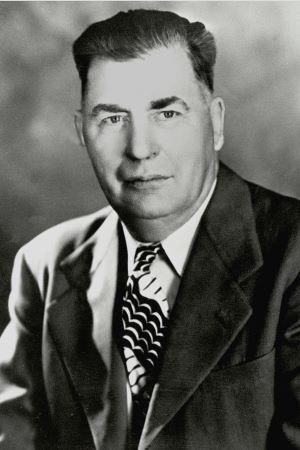Our series on Colorado’s governors continues with Edwin C. Johnson, Colorado’s 26th and 34th governor. Governor Johnson served two terms from 1933-1937, and then another term from 1955-1957. As part of the State Publications Library’s effort to digitize governors’ addresses, Governor Johnson’s 1937 message to the Colorado General Assembly is available in our digital collection.
Early life

Edwin Johnson was born in Scandia, Kansas in 1884. He spent most of his childhood and young adult life in Nebraska. Johnson graduated high school in 1903 and worked as a train dispatcher until 1909.
Johnson moved to Colorado in 1909 in the hopes that the sunny, dry climate would cure his tuberculosis. He and his wife spent one year recovering in Fountain, Colorado and then purchased a homestead near Craig. Their land was still wilderness when they bought it, so the couple had to live in a cave while they built their home.
Political career
Edwin Johnson, or “Big Ed,” had a long career in state and national politics and was popular amongst Coloradans; he was so popular that he is the only person to serve three terms as Governor and three terms in the United State Senate. Johnson won his first statewide election in 1923 as a Democratic candidate for the Colorado House of Representatives, a role that he held for four consecutive terms. In 1931, Johnson was elected Lieutenant Governor, preceding his first term as Governor, which began in 1933.
Johnson served as governor at two very different times in Colorado’s history. During his first term, Johnson’s primary task was to navigate the effect of the Great Depression on Colorado’s population. Although Johnson was a Democrat, he did not support national New Deal legislation, instead creating his own statewide relief program. The program included tax reductions, balancing the state budget, and a large-scale highway construction program. In his 1937 message to the General Assembly, Johnson highlighted the planning of a state highway system as point of pride in his first two terms. His administration was so instrumental in the development of these highways that the Eisenhower-Johnson Memorial Tunnel on I-70 was partially named in his honor.
Johnson’s second term was characterized by his 1936 attempt to close Colorado’s border with New Mexico to prevent migrant workers from entering the state, an event that is detailed in a History Colorado podcast episode titled, “A Line in the Sand.” At the time, Colorado’s economy was dependent on sugar beet farms that often employed migrant laborers from Mexico to harvest the beets. These jobs were often exploitative, and the laborers were paid meager wages for their work. However, Johnson thought that the jobs should be filled by unemployed American citizens and called out the National Guard to close Colorado’s southern border, blocking state entry to workers who either were Mexican or simply looked like they might be. It turned out that unemployed Coloradans mostly did not want jobs on sugar beet farms and Johnson faced intense pressure from the sugar beet lobby and the federal government to end the blockade and allow migrant workers back into the state – which he did, after ten days.
Johnson was elected to represent Colorado in the United States Senate and began his first of three terms in 1937. As a Senator, he was an isolationist and voted against American involvement in foreign wars but supported the war effort once the U.S. entered World War II.
While Johnson was an opponent of McCarthyism in Congress, he gave an infamous speech in 1950 about the extramarital affair of his former favorite actress, Ingrid Bergman. In the speech, he called Bergman an “apostle of degradation” and demanded that she be banned from American movies and television. He introduced legislation to adopt programming standards based on the morality of the actors that was ultimately unsuccessful. Colorado newspaper articles from the time treated his morality crusade with amusement.
After Johnson’s three terms in the U.S. Senate, he ran another successful gubernatorial campaign and became Colorado’s 34th governor in 1955. During his final term, Johnson continued advocating for an expanded state highway system and water reclamation projects throughout Colorado.
Life after politics
Johnson remained involved in state politics by serving on several committees, including the Colorado Commission on the Aged and the Upper Colorado River Commission. He was also involved in Colorado sports, serving as President of the Western Baseball League and contributing to the construction of Mile High Stadium. Johnson was inducted into the Colorado Sports Hall of Fame in 1968. Governor Johnson died on May 30, 1970 and is buried in Fairmount Cemetery.
- Growing container gardens in Colorado - March 21, 2025
- Colorado’s Scenic and Historic Byways: Grand Mesa - March 7, 2025
- Understanding Colorado’s electric vehicle tax credit - February 24, 2025